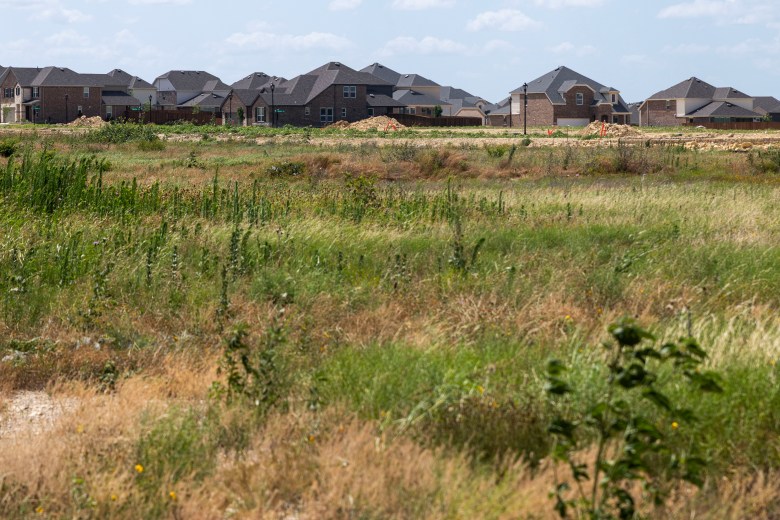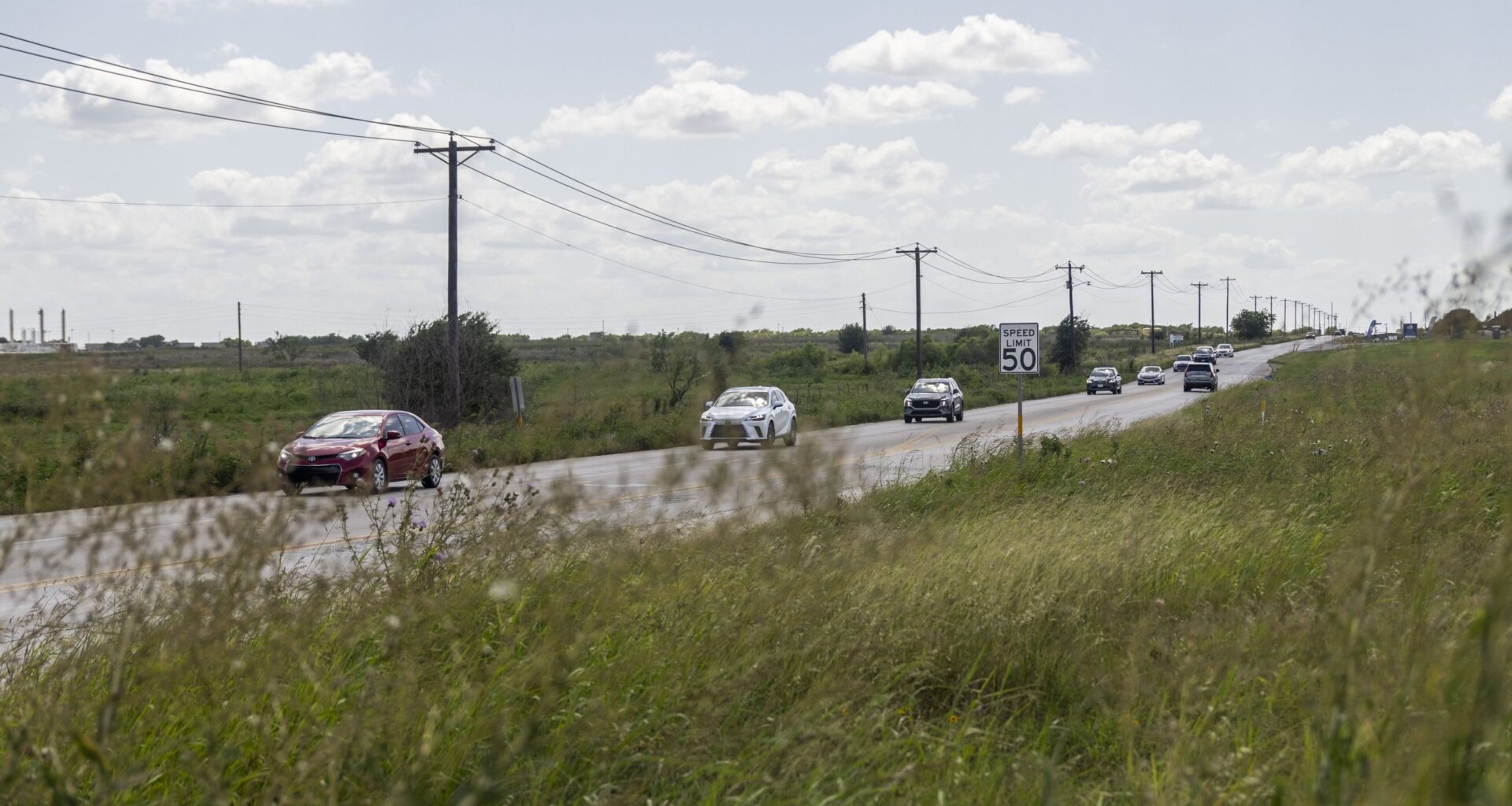Aaron Salinas’ morning commute begins with a 1-mile drive that typically takes him anywhere from 40 to 50 minutes.
The logjam between his driveway and U.S. 287? Bonds Ranch Road.
The two-lane country road stretches about 8 miles through land that was, until a few years ago, sprawling prairie along Fort Worth’s far northern border. It’s the only access point to Fort Worth for thousands of new residents in the area, whose commutes see them crawling east to the highway or west to Morris Dido Newark Road.
Officials from Tarrant County, Fort Worth and transportation entities held a public meeting on Monday to discuss a nearly $200 million project to tackle traffic woes along the Bonds Ranch Road corridor by widening the street, adding streetlights and making other improvements.
More than 150 people attended, as officials outlined designs and promised tentative groundbreaking dates over the next three years.
“This will be a behemoth of a construction project. You’re going to have to be patient with us,” said Dillon Maroney, executive administrator for Tarrant County’s Precinct 2.
The road’s worsening congestion has built up frustration in residents who’ve seen the area develop. During the past decade, thousands of houses have gone up in the once-rural area; covering the patchy native grasses with new turf and planting baby trees where dry brush once grew thick.
“It’s more than likely move time, because I’m not sitting through this anymore,” said Salinas, who bought his house in 2022 and has since seen cars collide and veer into fences on the road.
Some days, commutes are worsened by a train halting traffic at one of the road’s three railroad crossings. Congestion is compounded by cars trickling into the recently opened Eagle Mountain High School, which has capacity for 2,200 students.
Meanwhile, over 3,000 new homes stand to be developed in the remaining vacant land nearby as Fort Worth’s fast growth continues.
Tarrant County Commissioner Manny Ramirez, who took a lead on the project, emphasized that the project is a top priority. He told the Report he understands residents’ frustration, but he’s proud that entities are aiming to widen the road before the next large wave of houses is built.
“We can’t control the pace of growth, when it comes to new residential populations or commercial businesses moving here,” Ramirez said. “But what we can do is make sure that our infrastructure is ready for those new residents, and we can make sure that our infrastructure works for our existing residents.”
 Houses sit next to undeveloped land June 20, 2025, off of West Bonds Ranch Road in Fort Worth. (Mary Abby Goss | Fort Worth Report)
Houses sit next to undeveloped land June 20, 2025, off of West Bonds Ranch Road in Fort Worth. (Mary Abby Goss | Fort Worth Report)
Tackling traffic woes in six segments
The Bonds Ranch corridor project includes widening the road to four lanes with a median in the middle, sidewalks on the side and a 35 to 45 mph speed limit. Crossings will be built over or tunneled under the railroad tracks. Several traffic lights are planned along the road.
Officials break the project into six segments, each with varying budgets, funding sources and planning entities. The work is expected to last at least until 2029, as some segments don’t have a set groundbreaking date.
“We’re running with an aggressive timeline on everything,” Maroney said.
Ramirez led the project’s coordinating efforts, partnering with Fort Worth, the Texas Department of Transportation, the railway and the North Central Texas Council of Governments.
He told the Report that, two years ago, nobody had taken the lead on building out the road’s infrastructure. Traditionally, Tarrant County doesn’t engage in Fort Worth roads, but Ramirez saw Bonds Ranch as different because it borders the city and its unincorporated territory.
“We really just started driving the bus on the process, not because we necessarily wanted to, but because it was necessary,” he said.
Alan Blaylock, who represents the area on Fort Worth City Council, did not respond to requests for comment.
Blaylock previously told the Fort Worth Report he hears complaints about Bonds Ranch Road congestion almost daily.
“That is one of my top priorities,” said Blaylock, who is also a member of the Regional Transportation Council.
Fort Worth residents frustrated with timeline
Residents Mary and Stormy Weathers had one main takeaway after the presentation: They’re glad they’re retired, or they’d be moving if they weren’t.
Mary Weathers said she’d spend an hour of her commute driving the 2 miles from her house to the highway.
The couple, who moved to the area about 10 years ago, said they’ve seen the road’s traffic worsen and get more dangerous over the decade. People increasingly struggle to exit their subdivisions onto Bonds Ranch Road because of the road’s poor visibility and traffic.
“I specifically did not look at (moving into) some neighborhoods because I could see, ‘Well, you’re never going to be able to turn left out of there,’” Stormy Weathers recalled.
The couple was happy to hear the road’s roundabouts would be replaced with traffic lights, because traffic light intersections can be expanded more easily.
But the presentation didn’t answer their central question: How did it come to this?
“(The city) knows the developments are going on, why are we waiting so long to improve the roads?” Mary Weathers said.
Fort Worth City Council can’t control who buys land in the city’s extraterritorial jurisdiction, but it has approved multiple agreements with developers to build out the Bonds Ranch Corridor. These spell out that the city will provide services too and eventually absorb the neighborhoods.
Ramirez, the county commissioner, said he lives in the area and drives on Bonds Ranch Road every day, so he understands residents’ frustrations. He said residents can take comfort in knowing the county is prioritizing the project and the region, as they see it as the future growth driver of Fort Worth and North Texas.
“We’re stepping up to do something about it, and that’s why they’re going to have a brand-new corridor in less than half a decade, when, ordinarily, without our involvement, it would probably take 10 to 15 years.”
Last year, Fort Worth hit a population of 1 million. Much of the city’s recent growth has been in its far north. In March, it broke ground on a new far north library to help residents feel connected with the city.
To Salinas, the night’s presentation represented more of a delay to a project his neighborhood thought would be nearly finished by now, he said.
“I chose to move here because this was supposed to already be done,” he said. “You’ve seen all this growth, and all they do is keep adding.”
Officials asked residents to leave feedback and ideas for the designs that have yet to be finished.
Maroney, the county administrator, emphasized to the crowd the project’s “aggressive” timeline and partnership between governing entities. He and other officials laid out the different challenges — such as funding issues and the railway crossings — that make the project difficult for entities to pull off.
He said they aren’t just planning a road project — they’re planning a system.
“When you look at this on a map, after a few more years, you’re going to see connections all the way up to Avondale, Haslet, 287,” he said. “We’re going to see something start to form on a map where you can get places, raise your family, go to work and live a happy life.”
How the project is broken down:
Section 1:
Where: East of Morris Dido Newark Road to just west of Business 287.
What: Widens road to four lanes, makes it more level, and adds sidewalks and five traffic lights.
When: Estimated to break ground in March 2026.
Cost: $98 million.
Section 2:
Where: Business 287 intersection, two railroad intersections.
What: Routing Bonds Ranch Road through two railroad crossings, either by going over or under.
When: Project still in early design phase, with officials unsure what the timeline will look like.
Cost: Unknown, with North Texas Council of Governments and North Texas footing most of the bill.
Section 3:
Where: From the Business 287 intersection to Wagley Robertson Road.
What: Widens road to four lanes, makes it more level, adds sidewalks, dedicated turn lanes, and traffic lights at the Thatcher Road and Willow Springs intersections.
When: Groundbreaking date to be determined due to funding. At the earliest, construction will be ready to start in spring or summer 2027.
How much: About $34.6 million, engineering paid for by Tarrant County, construction paid for by Fort Worth.
Section 4:
Where: From Wagley Robertson Road to west of U.S. 287.
What: Widens road to four lanes, makes it more level, adds sidewalks and traffic lights at the intersection of Fossil Springs/Kittering Terrace.
When: Breaking ground spring 2026, finishing fall 2027.
Cost: $36.4 million, funded by Fort Worth through its 2022 bond, traffic impact fees on developers and miscellaneous funds.
Segment 5:
Where: The road’s third railroad crossing between Fossil Springs Drive and U.S. 287.
What: Builds a bridge over railroad. The road will be closed during construction, rerouting cars to newly constructed frontage roads.
When: Design to be complete in 2027, construction starting in 2028.
Cost: Unknown.
Segment 6:
Where: Bonds Ranch Road at U.S. 287.
What: Connects frontage roads along U.S. 287 and creates U-turns at Bonds Ranch Road.
When: Ground breaking summer 2027.
Cost: Unknown.
Drew Shaw is a government accountability reporter for the Fort Worth Report. Contact him at drew.shaw@fortworthreport.org or @shawlings601.
At the Fort Worth Report, news decisions are made independently of our board members and financial supporters. Read more about our editorial independence policy here.
Related
Fort Worth Report is certified by the Journalism Trust Initiative for adhering to standards for ethical journalism.
Republish This Story
Republishing is free for noncommercial entities. Commercial entities are prohibited without a licensing agreement. Contact us for details.
